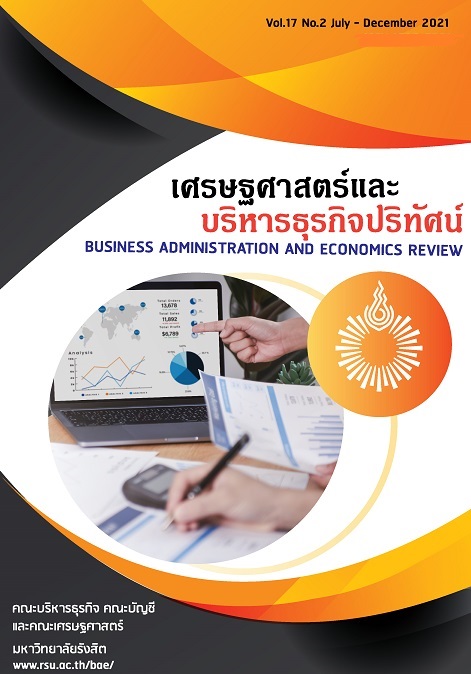Study of Cost, Break Even Point and Price Determination of Instant Rice Noodle Products
Keywords:
study of cost, break even point, price determination instant rice noodles products.Abstract
The purposes of this research to study the cost, break even point and price determination of instant rice noodle products in Phetchabun province. This research consisted of a combination of qualitative and participatory research. Key contributors in qualitative research are president and member of the community enterprise group and consumers of 30 people and participatory action research the research team consisted of 2 people, 9 students, 3 members of the community enterprise group, participated in the processing of instant rice noodle products (prototype). In order to calculate cost, break even point and price determination. the results it was found that the total cost was 40.93 baht, the most variable cost per unit was 40.82 baht or 99.73 percent and the fixed cost per unit was 0.11 baht or 0.27 percent. By adding 30 % of the desired profit, the product's selling price is 53.20 baht per unit, but if the price is set according to the psychological principle by setting odd-numbered prices that appeal to customers, the product price can be set at a price of 59 baht and consumers are more motivated to make a purchase when they receive a price reduction to 2 boxes of 100 baht, sales at break even point of 382 units, but if the business has reduced the price to 50 baht per unit to create incentives for purchasing from consumers, the sales at break even point is 757 units and the profit margin is 22.16 %.
References
Alnasser, N., Shaban, O.S & Al-Zubi, Z. (2014). The Effect of Using Break-Even-Point in Planning, Controlling, and Decision Making in the Industrial Jordanian Companies. International Journal of Academic Research in Business and Social Sciences. 4(5): 625-636.
Batkovskiy, A. M., Semenova, E. G., Trofimets, E. N., Trofimets, V. Ya. & Fomina, A. V. (2017). Statistical simulation of the break-even point in the margin analysis of the company. Journal of Applied Economic Sciences, Romania: European Research Centre of Managerial Studies in Business Administration. 2(48): 558-570.
Chaiprakong, T. & Kornlert, P. (2018). Study and Analysis of Cost, Volumn and Profit on Cotton Hand Weaving Products: A Case Study of Ban Nong Ab Chang Village, Sobtia Sub-District, Chom Thong District, Chiang Mai Province. Payap University Journal. 28(1): 71-83.
Constandache, N. (2011). The Break-Even Point and the Leverage Effect–Instruments for Assessing the Economic and Financial Risk. Acta Universitatis Danubius. 7(6), 20-33.
Ditkaew, K., Topunyanon, O. & Palala, S. (2015). Study Cost and Return of Product of One Tambon One Product: Case Study Sawaei Coconut. The 2nd National Academic Conference of the Research and Development Institute Kamphaeng Phet Rajabhat University. 439-444.
Heizer, J. & Render, B. (2009). Operations Management. 9th Edition, Prentice Hall, New Jersey.
Hiransomboon, K. (2006). Small business management. (7th ed). Bangkok: Text and Journal Publication.
Meemak,T., Samerjai, C. & Pitiruek, K. (2009). Small business management. Bangkok: SE-Education Public.
Sintha, L. (2019). Bankruptcy Prediction Model of Banks in Indonesia Based on Capital Adequacy Ratio. Journal of Finance and Banking Review. 4(1): 8-16.
Suranatthaku, K. (2016). Managerial Accounting. (3rd ed.). Bangkok: Aksnansophon.
Wiseansart, A., Pensuk, V., Nimala, N., Pariyajarn, S., Suriya, A. & Vilavong, S. (2014). Costs and Prices of Swine’s Processed Products of Farmers in Koklam and Sang Aram Villages under the Royal Project “Pidthong Langphra”, Kudmakfai Sub-district, Nongwuaso District, Udon Thani Province. Prawarun Agricul Tural Journal. 11(2). 149-158.
Otker-Robe, Inci and Anca Maria Podpiera (2014). “The Social Impact of Financial Crises Evidence from the Global Financial Crisis,” Policy Research Working Paper 6703. World Bank.
Downloads
Published
How to Cite
Issue
Section
License
Copyright (c) 2021 Business Administration and Economics Review

This work is licensed under a Creative Commons Attribution-NonCommercial-NoDerivatives 4.0 International License.
The contents in Business Administration and Economics Review can be used for publication. But do not modify, modify or use it for trade and profit.

